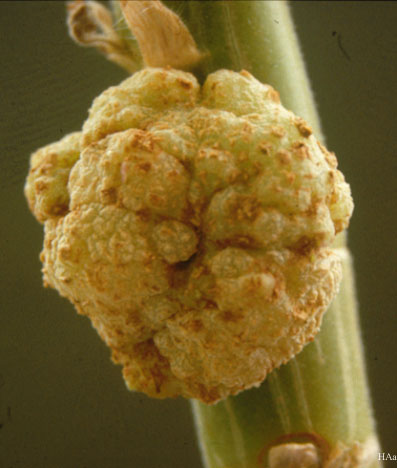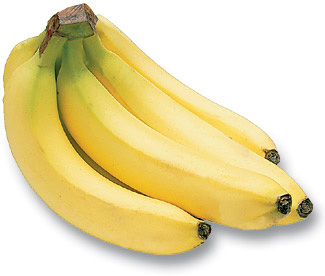Agrobacterium: Difference between revisions
Slonczewski (talk | contribs) No edit summary |
Slonczewski (talk | contribs) No edit summary |
||
| Line 1: | Line 1: | ||
Classification<br />'''Higher order taxa:''' Bacteria; Proteobacteria; Alphaproteobacteria; Rhizobiales; Rhizobiaceae; Rhizobium/Agrobacterium group <br />'''Species: '''''Agrobacterium agile, Agrobacterium albertimagni, Agrobacterium aurantiacum, Agrobacterium larrymoorei, Agrobacterium radiobacter, Agrobacterium rhizogenes, Agrobacterium rubi, Agrobacterium tumefaciens, Agrobacterium vitis, Agrobacterium ''sp. | ''Agrobacterium'' ''tumefaciens'' cells attached to a plant cell. From [http://www.genomenewsnetwork.org/articles/12_01/A_tumefaciens_genome.shtml Genome News Network and Martha Hawes]. | ||
|} | |||
{| width="800" cellspacing="2" cellpadding="2" align="center" | |||
| width="802" height="874" bgcolor="#ffffff" valign="top" | | |||
<font size="+1">'''Classification'''</font><br />'''Higher order taxa:''' Bacteria; Proteobacteria; Alphaproteobacteria; Rhizobiales; Rhizobiaceae; Rhizobium/Agrobacterium group <br />'''Species: '''''Agrobacterium agile, Agrobacterium albertimagni, Agrobacterium aurantiacum, Agrobacterium larrymoorei, Agrobacterium radiobacter, Agrobacterium rhizogenes, Agrobacterium rubi, Agrobacterium tumefaciens, Agrobacterium vitis, Agrobacterium ''sp. | |||
<font size="+1">'''Description and Significance<br />'''</font>At the turn of the century ''Agrobacterium tumefaciens'' was identified as the causal agent in crown gall disease in dicotyledonous plants. Since then, thorough research has been done on this bacterium's mechanism of tumor induction; in addition, ''Argorbacterium'' is used in numerous research projects as a means with which to introduce new genes into the genomes of a number of plants. | <font size="+1">'''Description and Significance<br />'''</font>At the turn of the century ''Agrobacterium tumefaciens'' was identified as the causal agent in crown gall disease in dicotyledonous plants. Since then, thorough research has been done on this bacterium's mechanism of tumor induction; in addition, ''Argorbacterium'' is used in numerous research projects as a means with which to introduce new genes into the genomes of a number of plants. | ||
| Line 10: | Line 15: | ||
| width="792" height="156" | | | width="792" height="156" | | ||
''Agrobacterium'' ''tumefaciens'' is a Gram-negative, non-sporeforming, rod-shaped bacterium. ''Agrobacterium'' strains use different carbohydrates and are classified into three main biovars. The differences among biovars are mainly determined by the genes on the circular chromosome. ''A. tumefaciens ''is known for calling the formation of galls on plants that it infects. When a wound opens on the plant tissue, the motile cells of ''A. tumefaciens'' move into the tissue by chemotaxis as a response to the release of sugars and other components normally in the roots. While ''A''. ''tumefaciens'' cells without Ti plasmids recognize and move towards plant wounds, the strains containing the Ti plasmids respond even more strongly because they recognize phenolic compounds such as acetosyringone that come out of the wound (Deacon). | ''Agrobacterium'' ''tumefaciens'' is a Gram-negative, non-sporeforming, rod-shaped bacterium. ''Agrobacterium'' strains use different carbohydrates and are classified into three main biovars. The differences among biovars are mainly determined by the genes on the circular chromosome. ''A. tumefaciens ''is known for calling the formation of galls on plants that it infects. When a wound opens on the plant tissue, the motile cells of ''A. tumefaciens'' move into the tissue by chemotaxis as a response to the release of sugars and other components normally in the roots. While ''A''. ''tumefaciens'' cells without Ti plasmids recognize and move towards plant wounds, the strains containing the Ti plasmids respond even more strongly because they recognize phenolic compounds such as acetosyringone that come out of the wound (Deacon). | ||
<font size="+1">'''Ecology'''</font> | <font size="+1">'''Ecology'''</font> | ||
''Agrobacterium'' ''tumefaciens'' can generally be found on and around root surfaces known as the rhizosphere. There it seems to use nutrients that leak from the root tissue. It will infect the tissue at wound sites formed from transplanting seedlings, burrowing animals or bugs, etc (Deacon). ''Agrobacterium'' ''radiobacter'' grows on various explosives such as nitroglycerine - they use this as their sole source of nitrogen. It removes two nitro groups from nitroglycerine by an NADH-dependent oxidoreductase, but can not use the carbon in nitroglycerine for growth because it cannot remove the third nitro group to release glycerol (White). | ''Agrobacterium'' ''tumefaciens'' can generally be found on and around root surfaces known as the rhizosphere. There it seems to use nutrients that leak from the root tissue. It will infect the tissue at wound sites formed from transplanting seedlings, burrowing animals or bugs, etc (Deacon). ''Agrobacterium'' ''radiobacter'' grows on various explosives such as nitroglycerine - they use this as their sole source of nitrogen. It removes two nitro groups from nitroglycerine by an NADH-dependent oxidoreductase, but can not use the carbon in nitroglycerine for growth because it cannot remove the third nitro group to release glycerol (White). | ||
| Line 57: | Line 55: | ||
[http://www.cf.ac.uk/biosi/research/molecular/staff/gfw.html White, Graham. The Molecular Cell Biology Research Group: Research ] | [http://www.cf.ac.uk/biosi/research/molecular/staff/gfw.html White, Graham. The Molecular Cell Biology Research Group: Research ] | ||
|} | |||
Revision as of 20:31, 26 May 2006
Agrobacterium tumefaciens cells attached to a plant cell. From Genome News Network and Martha Hawes. |}
|
Classification Description and Significance Genome Structure Cell Structure and Metabolism
Banana Vaccines
This has already been shown to work using potatoes and a modified E. coli protein that is known to cause severe diarrhea. When mice ate the raw engineered potatoes, they developed the antibodies to the E. coli toxin. Clinical tests on humans eating genetically engineered potatoes also showed that they started producing antibodies against Norwalk virus, which causes acute bouts of diarrhea (Redig 2003). For now, all clinical trials involve genetically modified potatoes or tomatoes, both of which can easily be freeze-dried, transported, and reconstituted. These can be more easily dosage regulated and quality controlled, unlike a banana tree growing in the middle of a village, for example. But the ideal of fresh banana vaccines is still being developed and perfected. References Updated July 28, 2005 Brown, Kathryn. 1996. "Vaccine Cuisine." Environmental Health Perspectives, vol. 104, no. 3. Abraham Loyter, Joseph Rosenbluh, Nehama Zakai, Jianxiong Li, Stanislav V. Kozlovsky, Tzvi Tzfira and Vitaly Citovsky. The Plant VirE2 Interacting Protein 1. A Molecular Link between the Agrobacterium T-Complex and the Host Cell Chromatin?Plant Physiology, July 2005, Vol. 138, pp. 1318-1321. White, Graham. The Molecular Cell Biology Research Group: Research |


